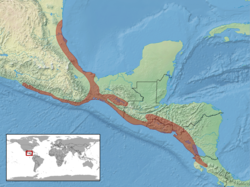| Coniophanes piceivittis | |
|---|---|
 | |
| Scientific classification | |
| Kingdom: | Animalia |
| Phylum: | Chordata |
| Class: | Reptilia |
| Order: | Squamata |
| Suborder: | Serpentes |
| Family: | Colubridae |
| Genus: | Coniophanes |
| Species: | C. piceivittis |
| Binomial name | |
| Coniophanes piceivittis Cope, 1869 | |
 | |
| Synonyms | |
Coniophanes piceivittis, known commonly as Cope's black-striped snake, is a species of small snake in the subfamily Dipsadinae of the family Colubridae. The species is endemic to Central America and Mexico, and is found in a wide range of habitats. [1] [2]
